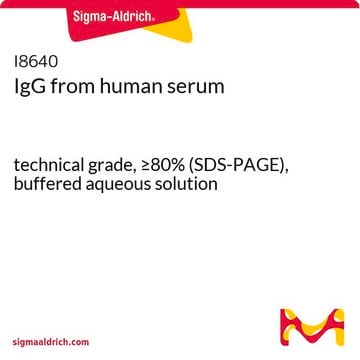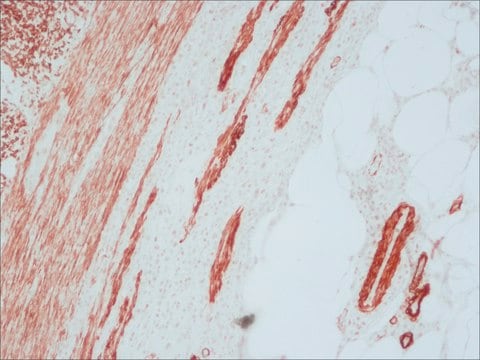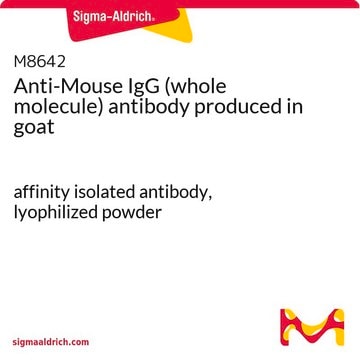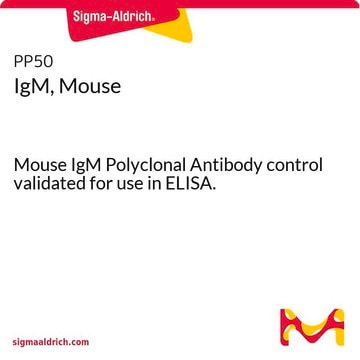I8765
IgG from mouse serum
technical grade, ≥80% (SDS-PAGE), buffered aqueous solution
Synonym(s):
Mouse IgG
Sign Into View Organizational & Contract Pricing
All Photos(1)
About This Item
Recommended Products
conjugate
unconjugated
grade
technical grade
Assay
≥80% (SDS-PAGE)
form
buffered aqueous solution
technique(s)
ChIP: suitable
immunohistochemistry: suitable
shipped in
dry ice
storage temp.
−20°C
Looking for similar products? Visit Product Comparison Guide
General description
IgG antibody subtype is the most abundant serum immunoglobulins of the immune system. It is secreted by B cells and is found in blood and extracellular fluids and provides protection from infections caused by bacteria, fungi and viruses. Maternal IgG is transferred to fetus through the placenta that is vital for immune defence of the neonate against infections
IgG from mouse serum specifically recognizes IgG from mouse. Mouse IgG is purified from normal mouse serum by fractionation.
IgG from mouse serum specifically recognizes IgG from mouse. Mouse IgG is purified from normal mouse serum by fractionation.
Immunoglobulin G (IgG) belongs to the immunoglobulin family and is a widely expressed serum antibody. A immunoglobulin has two heavy chains and two light chains connected by a disulfide bond. It mainly helps in immune defense. It is a glycoprotein. IgG is a major class of immunoglobulin. Mouse consists of five immunoglobulin classes- IgM, IgG, IgA, IgD and IgE. Mouse IgG is further divided into five classes- IgG1, IgG2a, IgG2b and IgG3.
Application
Technical grade IgG may be used as an economical alternative to the reagent grade immunoglobulins in applications where high purity is not required. IgG from mouse serum was used as negative control in immunohistochemistry at a concentration of 2 μg/ml. It was used as irrelevant control in chromatin immunoprecipitaion assay (10 μg).
Biochem/physiol Actions
Immunoglobulin G (IgG) participates in hypersensitivity type II and type III reactions. IgG helps in opsonization, complement fixation and antibody dependent cell mediated cytotoxicity.
Physical form
Solution in 0.01 M phosphate buffered saline, pH 7.2, containing 15 mM sodium azide
Disclaimer
Unless otherwise stated in our catalog or other company documentation accompanying the product(s), our products are intended for research use only and are not to be used for any other purpose, which includes but is not limited to, unauthorized commercial uses, in vitro diagnostic uses, ex vivo or in vivo therapeutic uses or any type of consumption or application to humans or animals.
Storage Class Code
12 - Non Combustible Liquids
WGK
nwg
Flash Point(F)
Not applicable
Flash Point(C)
Not applicable
Certificates of Analysis (COA)
Search for Certificates of Analysis (COA) by entering the products Lot/Batch Number. Lot and Batch Numbers can be found on a product’s label following the words ‘Lot’ or ‘Batch’.
Already Own This Product?
Find documentation for the products that you have recently purchased in the Document Library.
Customers Also Viewed
Oskar Vilhelmsson Timmermand et al.
Theranostics, 9(8), 2129-2142 (2019-06-01)
Androgen ablating drugs increase life expectancy in men with metastatic prostate cancer, but resistance inevitably develops. In a majority of these recurrent tumors, the androgen axis is reactivated in the form of increased androgen receptor (AR) expression. Targeting proteins that
Molecular Genetics of Immunoglobulin, 17 (1987)
Kamil Jastrzębski et al.
Journal of cell science, 130(3), 577-589 (2016-12-17)
Platelet-derived growth factor receptor β (PDGFRβ) is a receptor tyrosine kinase which upon activation by PDGF-BB stimulates cell proliferation, migration and angiogenesis. Ligand binding induces intracellular signaling cascades but also internalization of the receptor, eventually resulting in its lysosomal degradation.
Anne L Sapiro et al.
Cell reports, 31(7), 107654-107654 (2020-05-21)
Adenosine-to-inosine RNA editing, catalyzed by adenosine deaminase acting on RNA (ADAR) enzymes, alters RNA sequences from those encoded by DNA. These editing events are dynamically regulated, but few trans regulators of ADARs are known in vivo. Here, we screen RNA-binding proteins
The Laboratory Rat (1998)
Our team of scientists has experience in all areas of research including Life Science, Material Science, Chemical Synthesis, Chromatography, Analytical and many others.
Contact Technical Service











